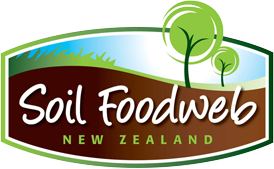
Soil Foodweb Books
We have 4 great books available at $45 ea plus GST
Written by Dr Elaine Ingham these manuals provide an easy-to-read, informative reference to the biological processes in soil, compost and compost tea/inoculums
Compost Tea Manual 5
Compost Tea in some form or other has been around since Roman times, but this manual instructs the reader how to take the process to a whole new level. Dr Ingham explains the full process from the importance of; The quality of the compost; The actions of the microbes; Aeration; Quality control and, finally, Application.
Soil & Foliar Foodweb
This informally written manual contains an explanation on how the soil and folia foodwebs effect and optimise the healthy production of plants. Containing plenty of illustrations and diagrams it describes in detail the roles and functions of the bacteria, fungi, protozoa and nematodes.
The Foodweb in Compost
Whether you are making a back-yard compost heap or involved with commercial compost production this manual will provide essential guidance in achieving a quality end product. It explains how to collect and classify your starting materials, how to manage and monitor the biology which in turn will help create compost for each specific production system.
Soil Biology Primer
This beautiful little booklet published by the Soil and Water Conservation Society in co-operation with the USDA Natural Resources Conservation Services. Text written by Dr Elaine Ingham. It is basically a synopsis of soil biological processes with pictures.
Articles
Book review - Whitewash, the story of a weed killer
-
Laurie PaytonOver the Christmas break I read a fascinating book by an investigative journalist named Carey Gillam. The title of the book was ‘WhiteWash.’ The story of a weed killer, cancer, and the corruption of science.
Erin Brockovich writes: “Whitewash reads like a mystery novel and Gillam skilfully uncovers Monsanto’s secretive strategies.” She is right on the money!
I have never been a fan of Glyphosate/Roundup. Anyone who knows me will be aware of that. I am suspicious of any chemical that kills a living thing, especially synthetically developed chemicals. I like to know what the collateral damage is going to be and I do not trust promotional blurbs on labels.
Whitewash book review
Whitewash, although full of facts and dates was extremely easy to read! The author includes case studies which humanises the story; tales about the experiences of farmers themselves. She has also included a reference material list as long as your arm in the back of the book. If you are so inclined it would be relatively easy to check the authenticity of material. I thoroughly recommend people get a copy and read it cover to cover.
So what details ‘stuck out’ for me?
I did not realise that it was common practice by cereal farmers to spray glyphosate as a desiccant (drying agent) on their crops a couple of weeks prior to harvesting. Cereals, including baby food, grown in the USA, Canada, and Argentina for example.
To satisfy my curiosity I conducted some quick searches on the net and found that generally, agricultural experts believe that provided the farmers use the product as per label instructions, there should be no residual in the grain, let alone the flour made from it. Yet Gillam relays the story about Joel Ransom, an agronomist at the state university of Dakota. He became so curious about the residues in flour he conducted his own tests on samples of locally grown red spring wheat flour, plus 4 samples grown in Saskatchewan, Canada. He found every single sample contained glyphosate residues.
The US Environmental Protection Agency (EPA) has decided that an acceptable dose for humans is 1.75mg/kg/day which is fivefold higher than the acceptable intake in the EU of 0.3mg/kg/day. The USA allows among the highest levels of glyphosate residues which critics say underscores the levels of influence Monsanto has with its regulators. Gillam provides lots of evidence to support this view in her book.
So dear reader: If you check my blogs from time to time you are more than likely to share my views regarding health of food production systems and environment. This book was terrifyingly absorbing, describing a huge number of detailed issues than I have mentioned above. I could not put it down. If you haven’t already done so get a copy. It’s available on Google books, BookDepository and Booktopia, plus other outlets I would think.
Healthy Grass Growth
-
Are you aware of how important what is happening under the ground is to promote healthy grass growth?
During autumn, after the dry of summer, there should be an explosion of activity in bacteria and fungi.
This is due to two things; higher soil moisture levels which stimulates better grass growth. Thicker, longer grass sward = more photosynthesis = more sugar exudate for the precious microbes.
This being said the root depth should also increase significantly which will set your crop up nicely for the coming spring.
Taken in autumn on conventionally managed irrigated dairy pasture you will note the roots depth is only about 9 too 10cm.
When Soil Foodweb NZ tested this soil for bacteria and fungi we found the fungal biomass was very low and hardly active. The fungal component was being totally out-competed by the bacteria. This in turn created a collapsed soil profile which lead to anaerobic conditions and nutrient loss.
If no changes had been made the outlook would have been bleak for the following spring.
Fortunately this farmer realised the importance of a balanced biologically active soil. The roots from the same paddock in the second photo show just how much the roots have grown. In 9 months they have doubled in depth, now down to 20cm. The soil has ‘opened’ up and anaerobic conditions are all but gone.
The nutrient cyclers; worms and protozoa had plenty to eat and a good environment in which to flourish. The conditions to ensure the biological life would thrive were all there: Water, food, home and comfort.
So what did this farmer do to set the soil environment for success?
He got his soil tested for starters – he realised he needed to know what was there and what wasn’t. He then applied biological inoculums with foods. In this instance he applied it through his pivot.
As you can see by this result the effort paid off in spades.
The Dirt Doctor
-
One of the most rewarding components of my job is the interesting array of people I work with.
A perfect case in point is an agricultural scientist by the name of Jim O’Gorman, otherwise known as the Dirt Doctor, Jim has a small property in Kakanui, just south of Oamaru overlooking the Pacific Ocean. Just gorgeous!
He once told me his mission is to discover ways of successful plant production utilising the simplest of tools. Something that he could pass onto third world societies where food production is challenging.
Jim sent me an email the other day with some great photos from his tomato green house. The variety is Potentate which was very popular in the 1960’s. It is open pollinated, not grafted, and not a hybrid. The photos show a beautiful crumb structured soil which is getting deeper each year.
Jim explains: Nothing unusual huh? Except…
Tomatoes have been grown biologically in the same soil for fifteen years.
The yield is greater than ever.
There is no whitefly
One only plant lost out of 150 (stunted)
Straight after tomatoes the house is planted in potatoes
The house is looking healthy
I should add here that Jim obtains biological assessments on his soils every year and we have noticed a continual improvement which supports his success.
His only fertiliser, pest and disease management are applications of his own composts and compost teas. The quality of his produce is so good that it is regularly requested by the Chef of Govenment House for state dinners.
Benefits associated with biological farming
-
Biological farming benefits include a reduction of chemical inputs, suppression of weeds and pests, improved animal health and fertility, reduction in water usage and improved pasture and crop quality without loss of production.
Although not apparent to the naked eye, a healthy soil is a dynamic living system that is teeming with life. Most of the organisms that live in the soil are beneficial micro organisms such as fungi, bacteria, protozoa, nematodes, worms and micro arthropods. While seemingly insignificant, they are represented in their millions in healthy soil, providing a range of important services that promote plant health and vigour.
The interactions among these organism can provide plants with all of the requirements they need to survive and flourish.
Biological farming aims to maintain a healthy soil balance and improved production results.








